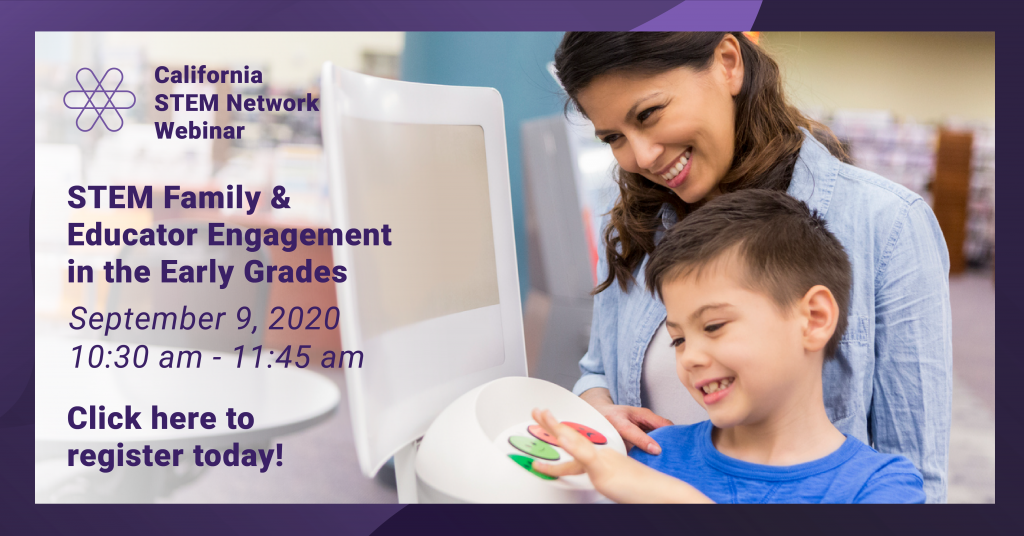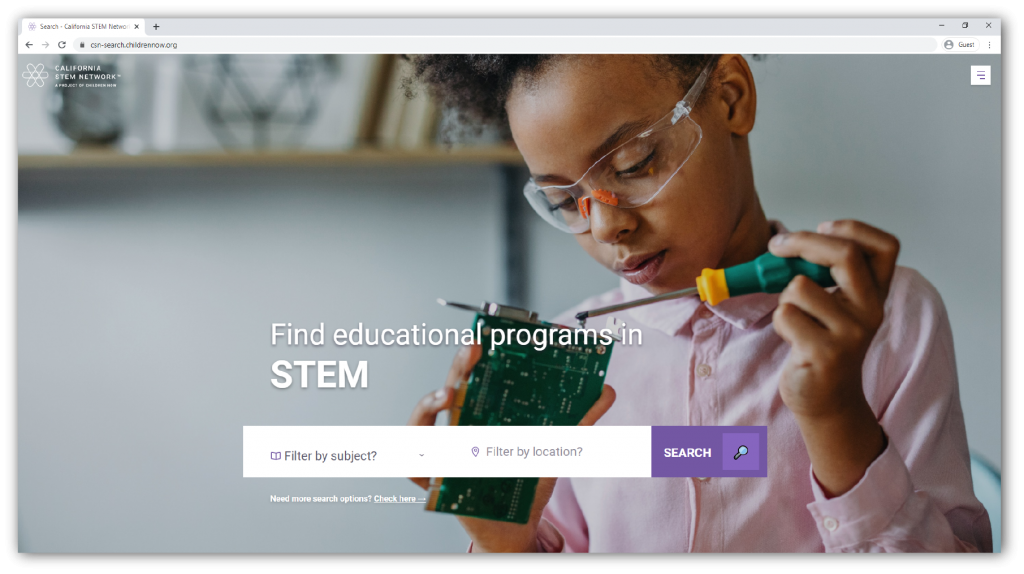In This Issue
- Family and Educator Engagement in Early STEM
- STEM Resource Inventory – Now Available
- Pre-College STEM Programs
- Program Spotlight
- State Board of Education Welcomes 3 New Members
- Legislation to Close the Digital Divide Advances in the Capitol
Family and Educator Engagement in Early STEM
You are invited to join us on September 9 from 10:30 – 11:45 a.m. for an engaging and informative webinar, Public Media Resources to Support STEM Learning. Presenters Susie B. Grimm and Frances Zazueta from PBS SoCal will share with us the model they have used to collaborate with schools, districts, and early learning organizations to provide online and blended STEM learning experiences for children ages 0 – 8 this fall. In addition, they will highlight the resources they have developed for both families and educators to support STEM learning in the early years. Prior to the pandemic, PBS SoCal worked closely with families and educators to support early learning in STEM. They leveraged the relationships and trust built through this work and their well-stocked library of high-quality, educational, and entertaining media resources to provide curated, quick, and free access to students and families when school buildings closed, and districts worked to transition to distance learning. Building on this experience, the team at PBS SoCal is offering virtual STEM Parent Academies, Math virtual camps (based on the PBS KIDS shows Odd Squad and Peg + Cat), educator webinars for distance learning with a focus in STEM and media and tech integration, virtual Family and Community Learning workshops, and digital backpacks this fall to support kids, families, and educators participate in high-quality, STEM learning experiences. Please join us to learn more about this work and how you may be able to partner with PBS in your local area.
STEM Resource Inventory – Now Available
The California STEM Network is pleased to announce that the STEM Resource Inventory is now available online! The inventory includes more than 100 STEM-based programs available to students, families, and students in the nine-county San Francisco Bay Area. The dynamic inventory includes key functionality such as searching by name, keywords, and location, filtering by grade-level, target audiences, and subject areas, and has been designed with growth in mind. The system allows for the submission of new programs and providers and enables program providers to manage their own listings.
If you are looking for a specific type of STEM program you would like to connect with, support, or learn more about, we invite you to explore the inventory. If you would like to be included in the inventory, or manage your listing in the inventory, we invite you to submit your information or contact us at [email protected]. For more information about criteria for eligible programs for inclusion in the inventory, please visit our Provider Information page.
As reported here previously, the California STEM Network and the Bay Area STEM Ecosystem are partners in the STEM PUSH Network, a four-year, multi-state initiative supported by the National Science Foundation that has brought together four regional STEM ecosystems (Bay Area, Pittsburgh, Chicago and New York) to work with equity-focused higher education institutions, educational organizations and corporations to broaden the participation of underrepresented groups (URGs) in STEM fields. Each participating ecosystem is working with precollege STEM programs in their regions to strengthen their programming for URGs and generate effective practices to contribute to the broader field of precollege programming and equitable design and implementation. On August 19, Vince Stewart, representing ecosystem leaders, served as one of three presenters during a national webinar describing the project and our progress to-date. The webinar was hosted by the Teaching Institute for Excellence in STEM, also a partner in the project, and a recording of the webinar should be available soon on their website. Upon completion, this work will result in an accreditation process that documents and communicates the value of precollege programs to create a currency that can be used in college admissions review and building stronger partnerships with postsecondary institutions.
Santa Clara University School of Engineering – Virtual Engineering Seminar
This free synchronous, online learning event provides selected high school students with a unique opportunity to explore introductory engineering topics. Taking place on Zoom over the course of two Sundays, students will participate in interactive panel discussions and break–out sessions spanning several areas of engineering. The application is due on Wednesday, September 25 by 5:00 p.m.
State Board of Education Welcomes 3 New Members
On July 6, three new members of the State Board of Education were sworn in by its president, Dr. Linda Darling-Hammond, all of whom bring quite diverse backgrounds and experiences to the Board:
- Ms. Cynthia Glover Woods is the Chief Academic Officer at the Riverside County Office of Education. She has worked as an instructional assistant, teacher, curriculum specialist, principal, professional development coordinator, curriculum director, and assistant superintendent of instructional services.
- Mr. James J. McQuillen, a Yurok tribal citizen, has served as the Director of the Yurok Tribe’s Education Department since 2004, overseeing three Head Starts, the nationally–recognized Yurok Language Program, a higher education program and several other services that support the advancement of tribal youth.
- Ms. Haydee Rodriguez is a bilingual and bicultural high school teacher and has been a National Board-Certified Teacher (NBCT) since 2005. She specializes in history, but has also taught theater, AP Spanish Language and Literature, AP Government, ELD, and AVID. Ms. Rodriguez previously served on the California Commission on Teacher Credentialing, where she chaired the Educator Preparation Committee.
With earlier appointments of Dr. Darling-Hammond, Mr. Matt Navo, and Ms. Kim Patillo Brownson, Governor Newsom has now appointed a majority of the voting members of the State Board of Education.
Legislation to Close the Digital Divide Stalls in the Capitol
Two bills introduced earlier this year, AB 570 and SB 1130, to help close the digital divide by modifying the California Advanced Services Fund to provide greater access to broadband internet service failed passage in both the Senate and Assembly prior to the Legislature’s adjournment on August 31st. Following are brief summaries of the two bills.
AB 570 (Aguiar-Curry) – Communications: Broadband Services: California Advanced Services Fund.
This bill expands and extends the California Advanced Services Fund (CASF) and makes several modifications to the program, including increasing the minimum speed of broadband infrastructure deployed by the CASF and creating a new account within the CASF to fund broadband infrastructure. Amendments taken ensure all funded projects to use future-ready infrastructure and make conforming changes with SB 1130.
Action: Ordered to Senate Inactive File at the Request of Senator Dodd on 8/28/2020
SB 1130 (Gonzalez, Lena) – Telecommunications: California Advanced Services Fund.
This bill revises the program goal of CASF to, by the end of 2024, approve funding for infrastructure projects that will provide “high-capacity, future-proof infrastructure…to no less than 98% of California households in each consortia region.” Current law establishes the program goal as, by the end of 2022, funding of infrastructure projects that will provide “broadband access” to no less than 98% of households in each consortia region. Additionally, the bill directs the California Public Utilities Commission, in approving CASF program infrastructure projects, to approve certain infrastructure projects in “unserved areas and unserved high-poverty areas,” each as defined in the bill, and to prioritize projects in such areas where internet connectivity is available but only below certain technical downstream, upstream and latency standards. Amendments taken remove the requirement that program goals must be achieved with existing resources and clarifies that the fund may not exceed $330 million.
Action: Ordered to Assembly Inactive File at the Request of Assembly Member Calderon on 8/30/2020


